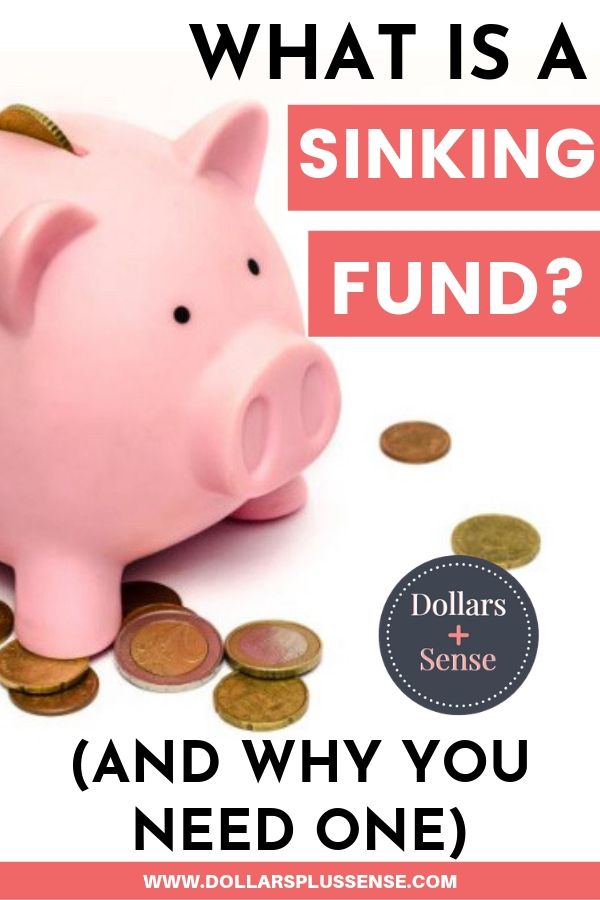Last Updated October 16, 2023
You probably have heard of the term “sinking funds” from some of your friends, or money gurus like Dave Ramsey, but never understood what they were. In this article, I will discuss what is a sinking fund, and why you probably need it.
What Is A Sinking Fund?
A sinking fund is when you set aside money specifically for a major purchase or a bill. In other words, you are basically saving up a little bit of money over time so the expense doesn’t catch you off guard.
How Is A Sinking Fund Different From My Emergency Fund?
Now that you know what is a sinking fund, you’re probably wondering how it’s different from an emergency fund. A sinking fund is different from your emergency fund because your emergency fund is for unexpected expenses.
Your sinking fund is for expenses you know will come up. For example, Christmas gifts, Thanksgiving dinner, or an annual vacation you like to take.
Why Do You Need A Sinking Fund?

I think a sinking fund is great because it specifies what you’re saving for. This keeps you more organized when you’re saving for multiple expenses at the same time. You know exactly how much you have saved for each expense separately.
Let’s say I would like to save for a vacation and Christmas gifts at the same time. For example, assume I’m saving $150 every month in a general savings account. This savings rate will give me a total of $1,800 for the year.
Assume at the end of 12 months I take a vacation that cost me $1,500. I am now left with $300. The problem comes when I’m ready to start Christmas shopping and I fall short because I needed $600 to cover all the gifts on my list.
Because I saved in a general savings account, I accidentally overestimated how much I could spend on my vacation.
All I saw was that I had $1,800 in my account, and that was more than enough to pay for my vacation. But I didn’t realize I was taking away money I needed for Christmas gifts.
In other words, by not keeping your savings goals separate, you may overestimate how much you actually have available to spend on one expense.

Here’s what the same situation would look like if I used a sinking fund:
- $50 for Christmas gifts
- $100 for vacation
At the end of the year my sinking fund totals would be:
- $600 for Christmas gifts, and
- $1,200 for vacation
When it’s time for me to take my vacation, I have two choices. I can take a cheaper vacation for $1,200. Or continue to save until my vacation sinking fund reaches $1,500. By having a sinking fund, I can choose to take my vacation and still be prepared for Christmas.

How To Create A Sinking Fund?
Determine how much money you need for an upcoming expense. Then take that amount and divide it by the number of months or weeks you have until you need to spend that money.
The figure you come up with will let you know how much you need to save every month or week towards that upcoming expense. You can use the Sinking Fund Worksheet in my FREE Resource Library to help you with this.
For example, say you want to save $1,800 for a vacation you want to take 6 months from now. Take $1,800 and divide by 6. You would need to save $300 per month for your sinking fund.
Or say you want to save $420 for Christmas, 7 weeks from now. You take $420 and divide by 7. You would need to save $60 every week for your sinking fund.
How Do I Include A Sinking Fund Into My Budget?
In the FREE Printable Monthly Budget Worksheet I provide, you can track your sinking fund under the “Savings Plan” section.
You can enter your starting balance, the amount you plan to save each month, and what your monthly ending balance is. I would put in parenthesis what my long-term savings goal is.
For example, assume I am saving $1,200 for my vacation sinking fund from the example I gave you earlier. I would write $0 in the “Starting Balance” box. Then write $100 in the “Monthly Savings Goal” box.
Next, write $100 in the “Ending Balance” box after I put aside my $100 for the month. Finally, next to the $100 I wrote in the “Ending Balance” box, I would write ($1,200) to remind myself what my long-term savings goal is.
Every month as I get closer to my goal, I would continue to keep my long-term savings goal in parenthesis. Look at the picture below to see an example of what I mean.


If you have more than one savings plan you want to track, I recommend getting my excel Monthly Budget template. This budget template is more detailed than the worksheet and allows you to add additional rows for multiple savings goals.
Where To Keep Your Sinking Fund?

Savings Account
I like to keep my sinking funds separate from my savings because I know exactly how much money I have set aside for what expense.
For example, I like to travel; therefore I have a separate savings account only for my vacations. Since I know I want to take a vacation at least every year, I know how much I can afford to spend on my vacations based on what’s in my vacation account.
If you open a separate savings account for your sinking fund, like me, make sure that account has a low (or no) minimum required balance.
I recommend CIT Bank because it offers competitive interest rates (right now it’s 10x the national average), have no monthly maintenance fees, and you only need $100 to open an account.
This is super important because you don’t want to be penalized for withdrawing your money once you are ready to pay for the expense you’ve been saving for. Also, their checking account has free ATMs worldwide.
If you don’t like the idea of having too many separate savings accounts, you can keep your total sinking fund savings in one account. However, this will only work if you keep track of how much money is allocated to each savings goal.
Cash Envelope
You can also save for your sinking fund by just setting aside money in separate cash envelopes. You don’t necessarily have to open up another savings account for this purpose if you don’t want to. This is a great way to save for unexpected expenses that come up throughout the year.
Summary
Now that you know what is a sinking fund, you should consider using one. You need a sinking fund to keep you more organized when you’re saving for multiple expenses at the same time.
It keeps all your savings goals separate so you know exactly how much you have saved for each expense. Using this method makes sure that your reoccurring planned expenses don’t catch you off guard. So start incorporating a sinking fund (or a few) into your budget today!
Related Articles:
- How To Build An Emergency Fund
- Step-By-Step Plan Every Beginner Needs For Financial Freedom
- How I Use My Monthly and Yearly Household Budget Spreadsheet
If you want to remember this article, pin it to your favorite Pinterest board.






7 Comments on What Is A Sinking Fund And Why You Need It?